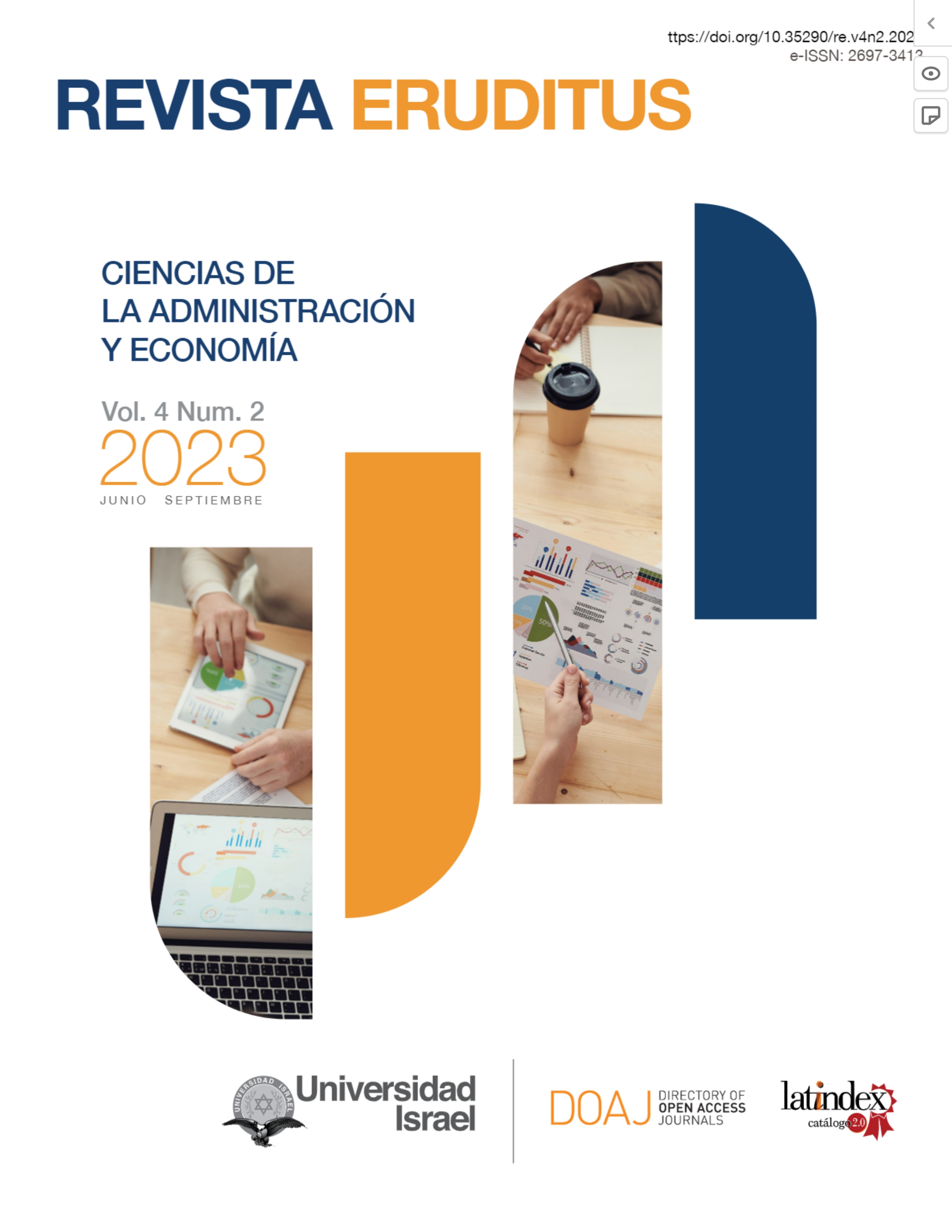Public investment in Mexico: crowding in or crowding out effect?
DOI:
https://doi.org/10.35290/re.v4n2.2023.875Keywords:
Economic growth, economic policy, public investment, investment, primary spendingAbstract
The relationship between public and private investment in emerging countries is a relevant topic, as it helps to better understand the role of government in economic growth. The objective of this study is to analyze the relationship between public and private investment in Mexico and to identify whether there is a crowding in or crowding out effect in the country. The crowding in and crowding out effects can be identified through a time series analysis; for this purpose, data on investment and primary expenditure in Mexico during the period 1993-2021 were used, together with cointegration tests and a linear regression analysis. As part of the conclusions, it has been identified that in Mexico there is a complementarity effect between both variables, verifying the leading role of the government in attracting private investment to the country.
References
Ahmed, H., & Miller, S. M. (2000). Crowding‐out and crowding‐in effects of the components of government expenditure. Contemporary Economic Policy 18(1),124–33. https://doi.org/10.1111/j.1465-7287.2000.tb00011.x
Caballero, E., y López, J. (2012). Gasto público, impuesto sobre la Renta e inversión privada en México. Investigación económica, 71(280), 55–84. https://www.jstor.org/stable/42779589
Castañeda, A., y López, T. (2023). Crecimiento económico, tipo de cambio real y exportaciones manufactureras de México, 1998-2020. Investigación Económica, 82(323), 53–79. https://doi.org/10.22201/fe.01851667p.2023.323.83890
Castillo, R., y Herrera, J. (2005). Efecto del gasto público sobre el gasto privado en México”. Estudios Económicos, 20(2), 173–196. http://www.redalyc.org/articulo.oa?id=59713036002
Furceri, D., y Sousa, R. M. (2011). The impact of government spending on the private sector: Crowding‐out versus crowding‐in effects. Kyklos, 64(4), 516–533. https://doi.org/10.1111/j.1467-6435.2011.00518.x
García, R., y Guevara, A. (2018). México: Del pacto corporativo de la sustitución de importaciones a la desregulación económica. Revista Científica UISRAEL, 5(2), 17-30. https://doi.org/10.35290/rcui.v5n2.2018.87
Gujarati, D., & Porter, D. (2022). Basic econometrics. Prentice Hall.
Gutiérrez, F. (2017). El impacto del gasto público sobre la inversión privada en México (1980-2015). Economía UNAM, 14(42), 136–49. https://www.elsevier.es/es-revista-economia-unam-115-sumario-vol-14-num-42-S1665952X17X00042
Guzmán, S. (2022). Los conflictos inflacionarios en México. Partido Acción Nacional.
Huerta, H., y Chávez, M. (2003). Tres modelos de política económica en México durante los últimos sesenta años. Análisis Económico, 18(37), 55–80. http://www.redalyc.org/articulo.oa?id=41303703
Johansen, S. (1988). Statistical analysis of cointegration vectors. Journal of economic dynamics and control, 12(2-3), 231-254.
Lean, H., & Tan, B. (2011). Linkages between Foreign Direct Investment, Domestic Investment and Economic Growth in Malaysia. Journal of Economic Cooperation & Development, 32(4).
López, C. (2022). México entrampado: cuatro décadas perdidas”. Revista Doxa Digital, 12(23), 154–164. https://doi.org/10.52191/rdojs.2022.251
Oladipo, O. (2007). Foreign Direct Investment and Growth in Mexico: An empirical investigation. Proceedings of the Northeast Business & Economics Association.
Ortiz, A. (1970). Desarrollo estabilizador: Una década de estrategia económica en México. El Trimestre Económico, 37(146):417–449. https://www.jstor.org/stable/20856136
Onyebuchi, M., y Ubaka, K. (2023). Public Debts’ Component and Crowding Out Effect of Private Domestic Investment in Nigeria. Nigeria Research Square. https://doi.org/10.21203/rs.3.rs-2461761/v1
Pachay, C., y Tubay, S. (2021). Análisis de la incidencia de las políticas fiscales en el sector Agropecuario de Ecuador periodo 2017-2019 [Tesis de Grado, Universidad de Guayaquil]. http://repositorio.ug.edu.ec/handle/redug/54093
Pamba, D. (2022). Crowding in or crowding out? Public Investment and Private Investment in South Africa: An ECM Approach. Prepints.org, https://doi.org/10.20944/preprints202201.0450.v1
Paredes, Y. (2023). Una mirada al pensamiento latinoamericano sobre el desarrollo. Revista Cientifica Legalis Et Politica, 2(1), 55–65. https://publishing.fgu-edu.com/ojs/index.php/RLP/article/view/328/551
Rodríguez-Benavides, D., y López-Herrera, F. (2014). Desarrollo económico y gasto público de las entidades federativas en México: Análisis de cointegración en panel y la ley de Wagner. Gestión y Política Pública, 23(2), 299–330.
Rodríguez, D., Mendoza, M., y Muller, N. (2022). Convergencia regional sigma débil en México: 1970-2019. Investigaciones Regionales-Journal of Regional Research 2022, 54, 29–49. http://dx.doi.org/10.38191/iirr-jorr.22.016
Ros, J. (2008). La desaceleración del crecimiento económico en México desde 1982. El Trimestre Económico, 75(299), 537–560.
Published
How to Cite
Issue
Section
License
Copyright (c) 2023 Juan Alberto Gracia Jasso, César Iván Mellado Ibarra, Yesenia Sánchez Tovar

This work is licensed under a Creative Commons Attribution 4.0 International License.
Los autores que participen de los procesos de evaluación y publicación de sus ediciones conservan los derechos de autor y ceden a la revista el derecho a la primera publicación, tal como establecen las condiciones de reconocimiento en la licencia Creative Commons Reconocimiento 4.0 Internacional (CC BY), donde los autores autorizan el libre acceso a sus obras, permitiendo que los lectores copien, distribuyan y transmitan por diversos medios, garantizando una amplia difusión del conocimiento científico publicado.
- Toda derivación, a partir de esta obra, deberá citar la fuente y a la primera publicación en esta revista. Se permiten derechos comerciales no lucrativos sobre sus contenidos.
- Los autores pueden realizar otros acuerdos contractuales independientes y adicionales para la distribución no exclusiva de la versión del artículo publicado en esta revista, es decir, podrán incluirlo en un repositorio institucional o publicarlo en un libro, siempre que indiquen claramente que el trabajo se publicó por primera vez en esta revista.
- Se permite y recomienda a los autores compartir su trabajo en línea, con la finalidad de intercambios productivos para una mayor y más rápida citación del trabajo como lo establece los efectos del movimiento ‘Acceso Abierto’.
- No puede aplicar términos legales o medidas tecnológicas que restrinjan legalmente a otros de hacer cualquier cosa que permita la licencia: https://creativecommons.org/licenses/by/4.0/deed.es
- La Revista Eruditus es financiada completamente de los aportes realizados por nuestra entidad editora: Universidad Tecnológica Israel; por tal motivo, no establece cargos o cobros de ninguna índole a sus autores y colaboradores, así como tampoco genera pagos o remuneraciones de ningún tipo a ellos.
- Se asignará un Digital Object Identifier (DOI) a cada publicación.



